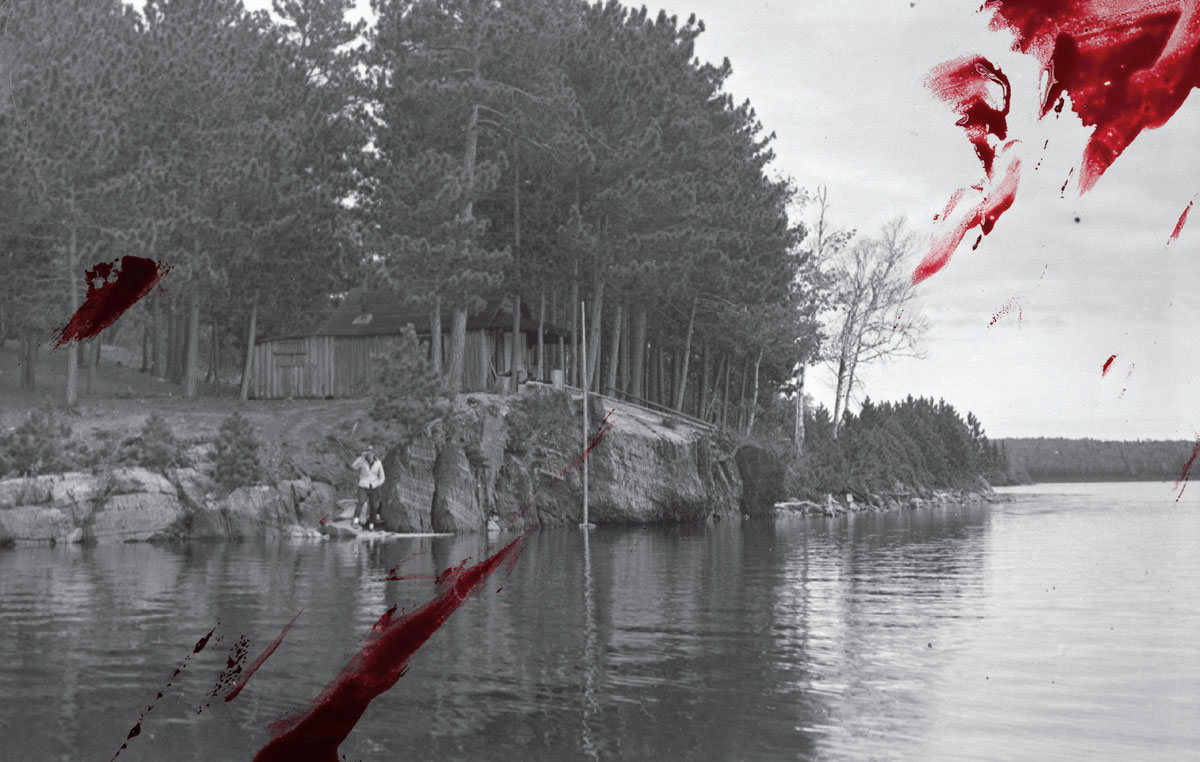By Andrew Vietze
From our August 2023 issue
On the morning of August 8, 1943, three gunshots rang out across Clear Lake, a wilderness pond in Maine’s Allagash region. Members of the posse combing the dense surrounding forest stopped in their tracks. They were game wardens, state troopers, sheriffs’ deputies, rangers, and guides, and they knew that three rifle reports in the Maine woods usually meant a hunter was lost or in distress.
On that day, however, it likely meant something else: someone within their ranks had found something. Or someone.
For more than two months, the men had been hunting the “Phantom of the Allagash,” a bearded bogeyman who haunted the north woods carrying a pack basket, an ax, and a shotgun he wasn’t afraid to use. Officials believed the man was, as a state-police bulletin put it, “a nervous, high-strung type who may be close to insanity . . . a very dangerous character [who] will shoot on sight.”
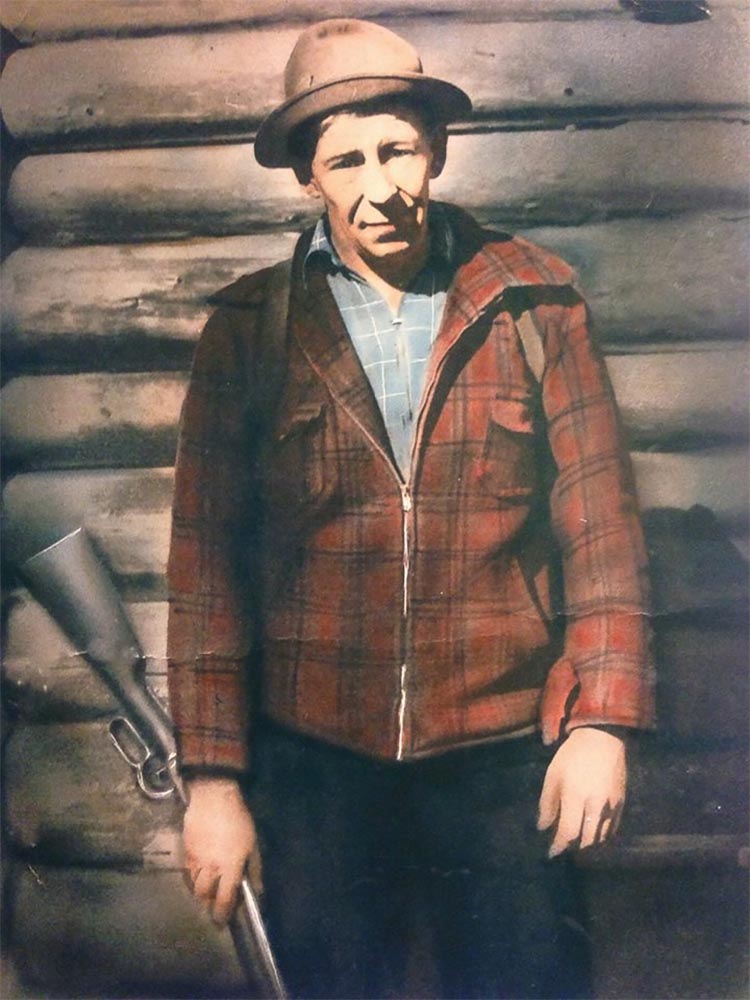
The search had been a slog through some of the most remote, blackfly-infested reaches of the eastern U.S., the wild lakes country where the southeastern sweep of the Allagash River drainage melds into what’s now the northwest corner of Baxter State Park. The men had spent weeks away from their families, clawing through thickets, plagued by unrelenting heat and bugs, scouring the forest floor for clues. All the while, they looked over their shoulders, knowing the phantom had already killed once and had fired shots at others.
The whole of Maine’s north woods region was on edge. The anglers, paddlers, and campers who normally filled the woods each summer had largely kept away. Those who lived and worked in the forest were anxious. A fire warden stationed at Second Lake had walked off the job. Gatekeepers had threatened to.
Did the three shots mean the north woods could rest easy? Had an end come to Maine State Police Case C-442, the longest manhunt in state history? Or did the gunfire indicate something more disturbing? Three shots, after all, were how the whole affair had started.
Two months earlier, on the evening of June 3, a Registered Maine Guide named Wesley Porter had sat down for dinner with three clients at a remote cabin on the north shore of Webster Lake, at the southern edge of the Allagash. The day had been ideal for fishing, and Porter knew how to put his “sports” onto fish. A 46-year-old potato farmer and father of eight from nearby Patten, Porter guided on the side for a sporting-camp owner named Arthur “Chub” Foster. He took Foster’s parties out to fish and hunt to make a little extra money doing what he loved — and guiding helped keep his mind off the fact that two of his sons were fighting Germans on the battlefields of Europe.
Porter, who’d been away from camp all day, caching supplies, asked his clients whether they’d been down near the dam at the east end of Webster Lake. Someone had messed about with supplies he’d stored there. No roads led to the long, 530-acre pond. Its only link to civilization was a telephone line that ran a couple of miles west, to the caretaker’s station at Telos Dam. The day before, the quartet had hiked nine miles to reach the camp, following winding Webster Stream, and Porter knew it was unlikely many others were around. For one, few were foolish enough to tangle with the blackflies.
But his clients — Robert Jarvis, 27; Robert Hames, 40; and William Buchanan, 52 — told Porter they’d been nowhere near the dam. In fact, they had spent the day three miles away, trying their luck on another nearby pond.
After dinner, as Porter cleaned up, the three stepped outside. Hames and Buchanan took seats on the porch, lighting their pipes. Jarvis descended the 14-foot ledge in front of camp to throw a line in the water, hoping to catch the next day’s bait. The fisherman heard a splash as Porter stepped out to clean off the dishes, tossing food scraps into the pond. Otherwise, the evening was quiet, until a scratching noise somewhere behind the cabin piqued Hames and Buchanan’s interest. The pair stood up and grabbed their .22 pistols, figuring it might be a porcupine.
Suddenly, the evening was rocked by a thunderous boom.
Jarvis whirled around to face the camp. “What in hell are you fellows shooting at?” he screamed. Two more blasts shook the dusk, and the young angler ducked. Ammunition cut the air over his head.
“My god, Wes, what’s happened?” Jarvis heard Buchanan cry. He scrambled back up the ledge to find Porter lying on the ground, the dinner pan still in his hand, blood pooling around his head. The guide was bleeding profusely from behind his left ear, a gash on his neck, his upper lip shredded, and two of his front teeth missing.
Buchanan rushed inside and dialed the caretaker at Telos Dam. Soon, the great north woods phone tree was rippling, with calls reaching the sheriff’s office in Greenville. Jarvis canoed down the lake, looking for help.
About an hour later, Piscataquis County medical examiner Frederick Pritham arrived by float plane to find Porter still hanging on — unable to move or speak, but breathing. Kneeling beneath the dull glow of a kerosene light, the doctor confirmed the obvious: Wesley Porter had been shot in the head. The assailant, Pritham estimated, had stood 30 or 40 yards away as they pulled the trigger of a small-caliber firearm. Pritham did what he could to keep Porter comfortable, but there was no moving the severely wounded guide. Wesley Porter died of his injuries shortly after midnight.
Early the next morning, deputy sheriff Dave Knowlton and state trooper James Mealey arrived in a Civil Air Patrol plane. They confiscated firearms from the Massachusetts sports — Mealey would turn them over to forensics — and grilled each one independently, finding that all three told basically the same story. Later in the day, Lieutenant Merle Cole, a 19-year veteran of the Maine State Police and a backcountry specialist, arrived to take charge of the investigation. The first suspects were the obvious ones: Porter’s clients. Did any have a beef with their guide? Did they get to drinking and become belligerent?
In Greenville, the state pathologist removed particles from Porter’s brain, which Cole told reporters were “drop lead or buckshot and contained no alloy such as would be found in a rifle or revolver bullet.” Meanwhile, ballistics on a Remington Kleanbore shotgun shell found at the scene showed two distinctive characteristics: the way the firing pin had scored the shell and an unusual lubricant used in the barrel, bacon grease.
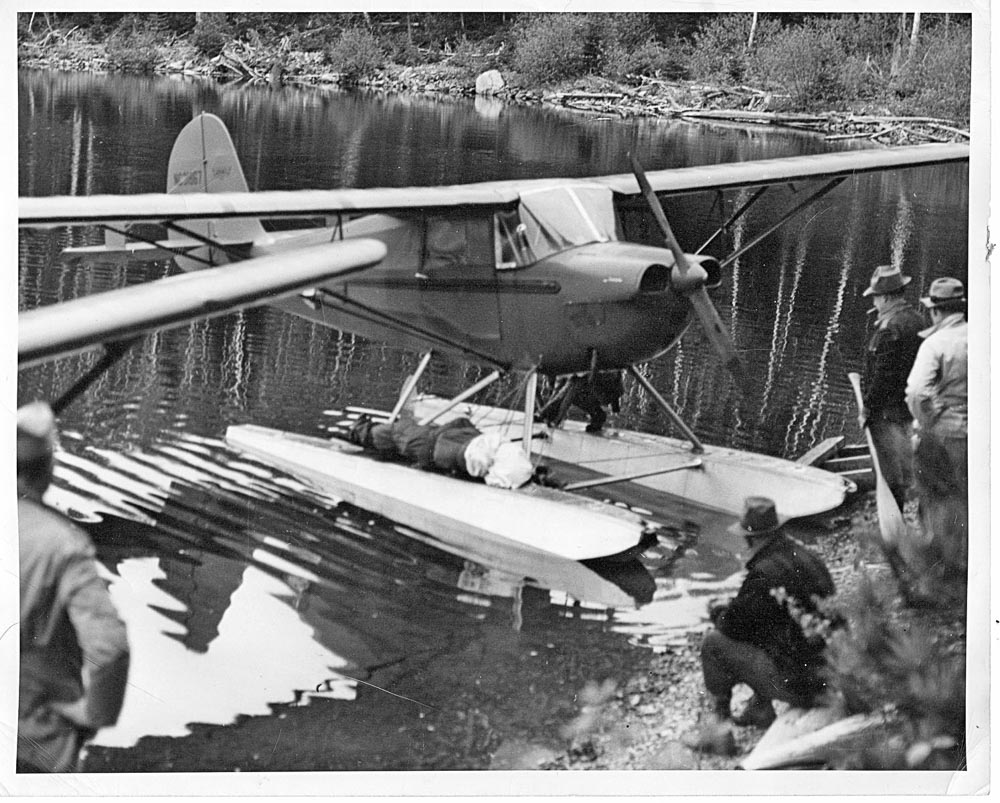
State police cleared all of the Massachusetts men’s guns. But if not them, then who?
In the days following the murder, Cole’s investigators interviewed more than 40 residents of the Allagash region, and the lieutenant quietly amassed a list of suspects: A poacher from New Hampshire, known to frequent the area. A German immigrant suspected of subversive activity. One of Wesley Porter’s own nephews. A “woods-queer” hermit who lived on nearby Hudson Pond, famously misanthropic and known to threaten hunters and fishermen. One by one, however, Cole and his men determined that all of them checked out.
Then, after a month of digging, a frustrated Cole got a tip from the commissioner of the state warden service. In the month leading up to the crime, about a dozen camps had been broken into in the Allagash region, and with sightings reported of a nattily bearded stranger. Wardens suspected the mystery man had been burgling the region for more than a year. Cole wondered, could this be the murderer? If so, why would he want Wesley Porter dead?
As the hunt for Porter’s killer stretched into summer, Maine’s papers covered the guide’s funeral and the search for the killer, while wire services sent stories about the murder and the fruitless investigation all across the country. “Law officers have sought in vain a clue to the mysterious assailant,” the Waterville Morning Sentinel declared in mid-July. “The region is mysterious enough without a man-made tragedy,” the paper’s outdoors columnist chimed in.
Six weeks in, the investigation had grown so stagnant that the state attorney general ordered Porter’s body exhumed, directing the state pathologist to look for anything that might have been missed. The new autopsy revealed another pellet in Porter’s brain, and spectrographic analysis confirmed it had come from a shotgun. Cole told reporters, “We were all convinced that the murder weapon was a 20-gauge, and by this time, we’re pretty sure that our man [is] still in the woods, hiding out.”
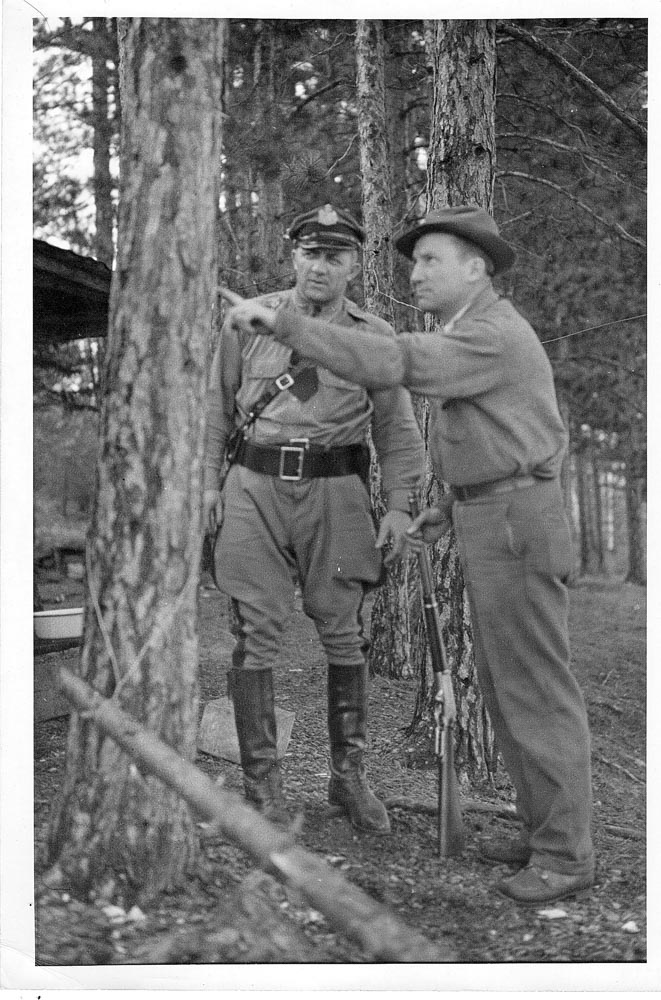
Meanwhile, break-ins continued in the Allagash. Investigating one of them, at Nugent’s sporting camp, on Chamberlain Lake, state wardens Helon Taylor and Bert Duty found a 20-gauge shell matching the one seemingly used to kill Porter. The burglar had shot through a window. Soon after, the pair visited the site of another camp invasion, at Snake Pond, some six miles northeast, where someone had again blasted their way in. Taylor and Duty recovered another shell, lubricated with bacon fat and scored by the same firing pin. Following a faint trail, they also found a lean-to where someone had recently camped.
Not long after, in late July, state trooper Mealey spied the suspect while investigating a report of stolen items at a fire tower. He lost him in pursuit but got enough of a look to provide details for a composite sketch. The phantom, Mealey said, was slight of build, no taller than 5-foot-7, with a long, dark, and red-tinged beard and a “bull neck.” He carried a pack, an ax, and a gun. The police distributed a thousand copies of the sketch to post offices, lumber crews, Customs officers, Canadian Mounties, and others.
At last, Cole and the other investigators felt like they were catching up to their killer. As July gave way to August, a Civil Air Patrol pilot spotted yet another abandoned encampment and a fire tower lookout reported his cabin shot up. Warden Duty was investigating another camp break-in when buckshot exploded through the thin walls, raking a chair he’d just vacated — again, the shooter escaped into the woods. What investigators needed, Cole decided, were bloodhounds, which Maine State Police didn’t have. In early August, the governor approved Cole’s request to obtain some, and Connecticut State Police sent a pair of dogs, with handlers, to join the dozens of men closing in on the phantom.
On August 8, Arthur “Chub” Foster and Clinton Porter, Wesley’s boss and his 16-year-old son, were a few miles north of the searchers’ Clear Lake camp, surveilling a tote road north of Fourth Musquacook Lake, when they spied a man who looked just like the police sketch. Foster, a WWI vet, leveled his gun and called out, “Just a minute, mister!” The bearded stranger turned, dropped his ax, and made to raise his shotgun.
“As the gun came up, I didn’t dare take a chance,” Foster later told the papers. “I felt it was one or the other of us. I pulled my rifle up and fired. The man staggered, cried out, and then collapsed on the ground.”
The much-feared Phantom of the Allagash turned out to be an emaciated shell of a man. Foster and Porter stanched the blood hemorrhaging from where he’d been hit in the thigh, then put him on an improvised litter, hauling him to where they could signal a plane. Their three shots echoed through the woods, indicating an end to the search.
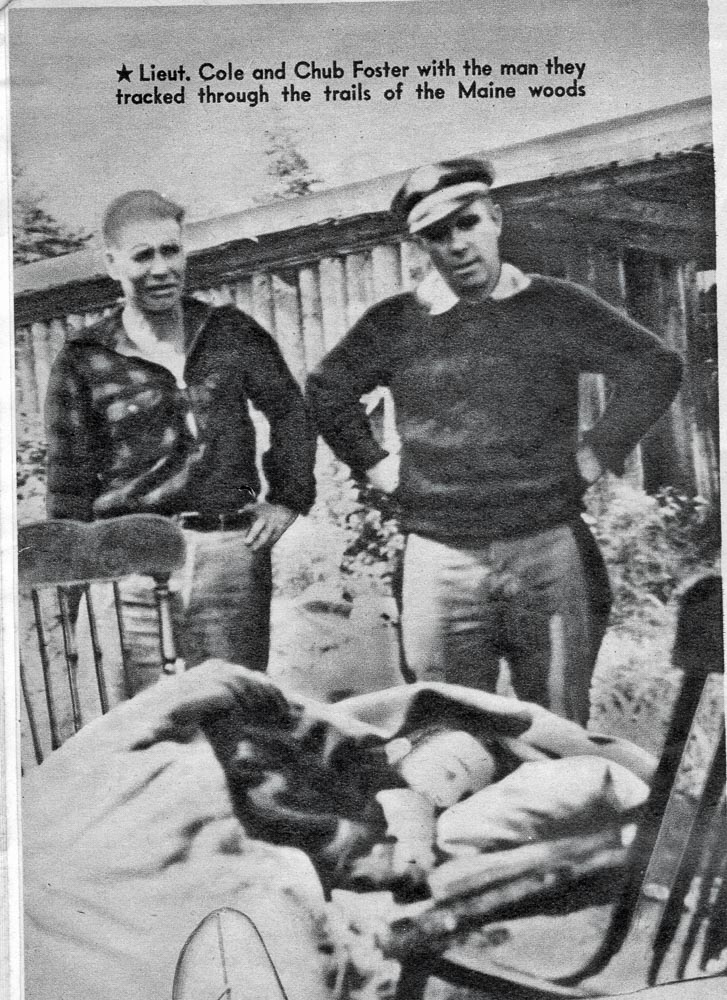
Within an hour, a floatplane delivered Lieutenant Cole and other law-enforcement officers to the scene. Speaking French, translated by a warden, the injured fugitive made his confession: His name was Alphonse Maurence. He was 35, unmarried, and had fled his home in Quebec to escape conscription into the Canadian military. For more than a year, he’d survived in the Maine woods by breaking into camps and stealing, firing into them first to make sure no one was inside. Early that summer, he’d found supplies on the shore of Webster Lake and tried to take them, but Porter had come along as he scavenged. So Maurence followed the guide back to camp, and as darkness fell, he fired shots meant to scare off the men he saw there — killing Porter, he claimed, by accident. He was hungry and desperate. He hadn’t meant to hurt anyone and had been on the run ever since. That morning, he had taken to the tote road in order to travel faster, after hearing the baying of the bloodhounds.
Forensics would later confirm the shells containing the shot that killed Porter had come from Maurence’s shotgun. In its barrel were traces of bacon fat. From the woods, Maurence was flown to Greenville, where he succumbed to blood loss at the hospital before he could be turned over to authorities.
The story of Porter’s murder and Maurence’s capture — what the Morning Sentinel called the “greatest manhunt ever staged in this state” — captivated not just the north woods but the nation. The Boston Globe ran updates on the search, which ultimately became fodder for the popular crime magazines of the day. Publications like True Detective and National Detective, which reached millions of readers, cast Porter’s death as a killing in one of the nation’s last, fading frontiers. “Time was when news of a murder in Maine’s vast northern woods wouldn’t reach civilization for days,” reflected the author of “Ghost Killer of the Allagash,” in Inside Detective magazine. National Detective sandwiched its story, “Strange Case of the Stalking Terror,” between the potboilers “Corpse in the Carpet” and “Murder Without Penalty.”
Eighty years later, the tale of the Webster Lake murder is still told around campfires in the north woods, still a topic of conversation among those from Porter’s hometown of Patten. One Patten native with a law-enforcement background, Susan Roy Morrison, curates a detailed website about the crime, collecting accounts from news archives and descendants of those involved, including of Porter himself.
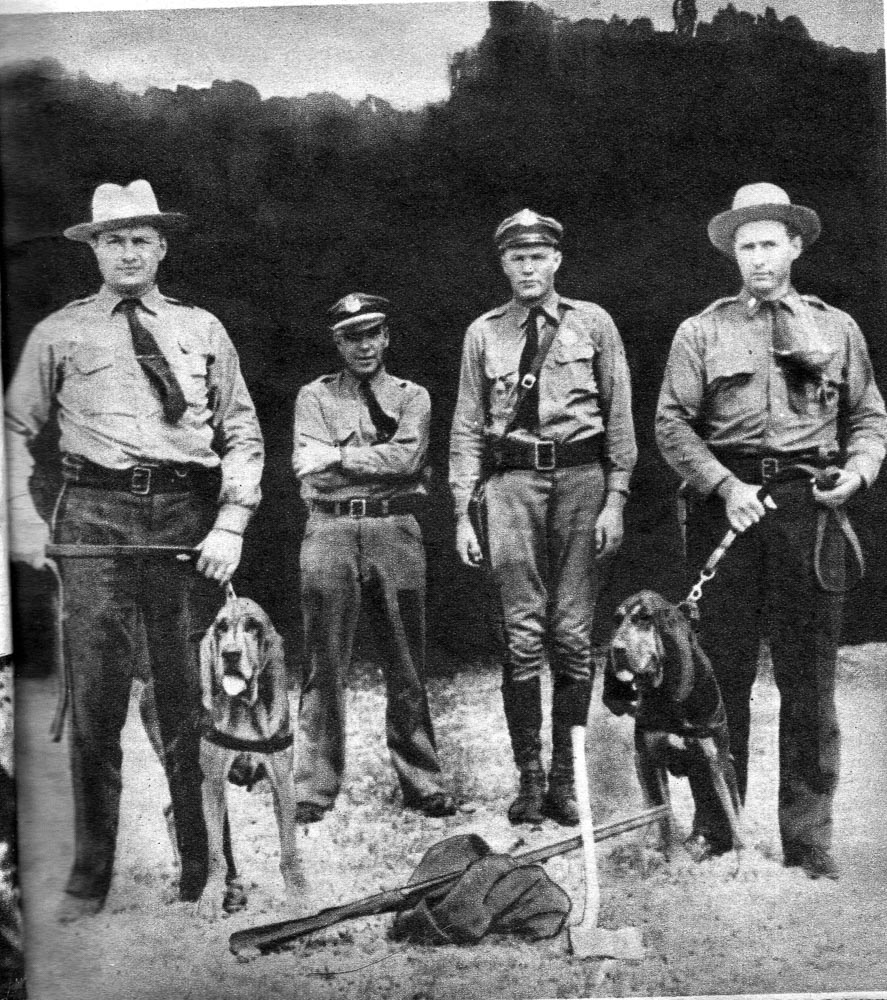
Donna Porter Roach grew up in the small Penobscot County community, hearing stories about the grandfather she never got to meet. “I remember my dad telling me the story about his father’s death,” says Roach, now a nurse living in Massachusetts. “He cried telling me, all those years later.”
As a kid, she was haunted by the idea of a bogeyman in the woods. “It literally made me afraid of the dark,” Roach says. “My father loved to hunt and fish, and I thought, ‘Please, god, don’t let that happen to him.’”
The man who shot the Phantom of the Allagash, Chub Foster, ran his sporting camp on Grand Lake Matagamon until 1970 and lived on the lake until his death, in 1995, at 97. He was a quiet man but loved telling tales of the old Maine woods, remembers Tom Johnston, who got to know him while guiding at the scouting camp opened on the site of Foster’s camp. Johnston heard the story of the manhunt straight from the man who’d ended it — along with countless more swashbuckling tales of the era’s guides, hermits, and other characters. “Of course, we teenagers ate them all up,” Johnston recalls. “At the time, that country felt like an isolated backcountry. Regardless of paper-company roads and a high volume of visitors, the Maine north woods felt like one of the last great empty spaces in the world.”
“That’s not easy terrain for anybody,” agrees retired state trooper Mark Nickerson, who researched the pursuit of Porter’s killer for his 2015 book Behind the Blue Lights, which collects tales from the archives of the Maine State Police. The duration of the search alone was impressive, Nickerson says — until 2015, it was the longest manhunt in state history. For years, he says, the details of the case were taught to new recruits at the Maine Criminal Justice Academy, and he marvels at the investigators’ ingenuity.
“They were able to put the timeline together of when these camps were broken into. They were able to figure out the direction he was traveling. They put together so many clues.” And they did it, Nickerson says, with rudimentary communication — “you know, wires hung through trees” — while coordinating multiple agencies across a vast wilderness. Is it any wonder the case transcended pulpy headlines to become a fixture in north woods lore?
“It’s just amazing they were able to cope,” Nickerson says. “It was just dogged determination to get this guy.”


